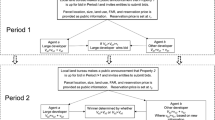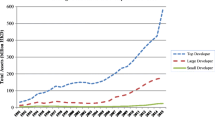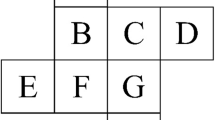Abstract
This paper studies the extent to which equilibrium land auction prices are pushed up sequentially due to strategic bidding behaviors in government land auction sales. Using a unique dataset that covers the universe of tendering prices submitted by all developers for all residential land auction sales in Singapore, we find that a tenderer’s bids are significantly higher where there was a previous land parcel sold within two years and located within four kilometers. The identified price margin decreases with time and geographic distance. Tracking sequential bids submitted by the same developer over time, we find that the incumbent winner of a previous auction is more likely to participate in subsequent nearby land sales as compared to the second-highest bidder of the same auction. However, it does not necessarily win the subsequent sites. We argue that the incumbent deliberately bids up the subsequent land prices to gain pricing advantages to their own parcels.




Similar content being viewed by others
Notes
Singapore is as another standard example where the government regularly releases land for private sector development through the government land sales (GLS) program. In certain parts of Europe, such as Sweden and the Netherlands, central or local government also buys up land well ahead of anticipated development, and sells it to developers as it is required.
Chinese land sales used to be conducted through negotiations in the 1990s. It had been heavily criticized for nurturing corruption and, hence, prompted a series of reforms. In particular, a 2002 law banned negotiated sales by land bureaus and required all urban leasehold sales for private development to be done through public auctions. Sealed bidding, as an example, has been widely adopted in Beijing and Shanghai, two largest cities in China.
Majority of the existing literature on real estate auctions are empirical studies. See for instance, Ashenfelter and Genesove (1992), Lusht (1996), Quan (2002), Ching and Fu (2003), Ooi and Sirmans (2004), Ooi et al. (2006), Tse et al. (2011), etc. Comparatively, only a small fraction of the theoretical literature on auctions focuses specifically on real estate (Quan 1994; Han and Strange 2015).
It is so after adjusting key observed characteristics of both parcels of land.
Final consumption goods, in a standard auction setting, are associated with either independent private values or common values unknown to bidders ex ante. The value of these goods directly adds to a buyer’s payoff upon procurement. The procurement of land, however, is used as intermediate inputs in a bidder’s profit maximization decision at a later stage. In this sense, the auction outcomes at the initial stage generate externalities that influence future interactions among bidders. There is a literature on simultaneous auctions with externalities that considered various situations where the change of ownership by auction sales affects the nature of subsequent interaction in the respective markets. Examples include changes in ownership in oligopolies through takeover and merger, the licensing of innovations to downstream competing producers, the deteriorated reputation that impacts subsequent winning probability, purchase of intermediate input from a manufacture, etc. (Gilbert and newbery 1982; Kamien and Tauman 1986; Katz and Shapiro 1985, 1986; Hart et al. 1990; Kamien 1992; Segal 1999; Jehiel and Moldovanu 2000). Researchers in this field often assume that bidders have private information about incurred externalities and focus on the efficiency and revenue-maximizing procedures of implementing simultaneous auctions. So far to our knowledge, no studies have investigated auctions that involve the sequential sale of an intermediate good and specifically modeled the subsequent competition between final substitutable products. There is neither empirical work that rigorously verifies various implications of similar types of model.
If there is true benefit associated with winning the subsequently launched sites and that is not particular to the previous winner as in the case of common value auctions, we would imagine that the incumbent winner would not have a stronger incentive to participate in subsequent launches (after controlling for capacity constraints) compared to other bidders. If however benefits of obtaining subsequent sites accrue mainly to the winner of a previous site out of monopoly or externality reasons, the incumbent should incur a higher reserve price and hence will be more likely to win the subsequent sites (after controlling for capacity constraints). Hence the discrepancy in participating and winning the following sites (after controlling for potential capacity constraints) seem to be inconsistent with the hypotheses on uncertainties, monopoly, or externalities.
There is only one residential site in our data that has 60-year leasehold tenure. This short-term lease site is zoned for residential development and can be developed into a condominium or flat.
The reserve price, which is not revealed to bidders, is set equal to 85% of the Chief Valuer’s assessed market value for the development site. The valuation, which is submitted by the Chief Valuer in a sealed envelope before the tender closing date, is opened at the same time as the received bids.
Also in Asia, Chinese land sales used to be done by negotiation, which was notorious for corruption. For that reason, a 2002 law banned negotiated sales by land bureaus and introduced public auctions for leasehold land sales. In Hong Kong, the method of sale for the government sites is open auction, which is more susceptible to collusion among bidders (Ching and Fu 2003).
Condominiums in Singapore take up about 10% of the overall housing market share and are designed as luxury living quarters to cater high-income home buyers. As shown in Baltagi and Li (2015), they all contain fully furnished units and share similar designs and similar luxurious outdoor amenities. In the Singapore context, condominiums that are launched close in time and also close in proximity are highly substitutable.
Both c 1 and c 2 can be endogenously solved for a sub-game perfect Nash equilibrium. However, this paper will not solve the whole model but instead we focus on how profit maximization in the second stage leads to differences in c 1 and c 2 in the auction stage.
\( \frac{\partial {\pi}_1}{\partial {c}_2}>0 \) because, as noted by Salop and Scheffman (1983), high-cost rival may reduce output, allowing the predator to raise price or market share. This is true especially if firms are financially constrained with their investments. With a large amount of investment to obtain patent, for example, financially constrained investors end up having less resources at disposal to expand business. In the context of land sales, financially constrained rivals, once have spent a significant amount to obtain the land parcel, may end up cutting output which increases the predator’s profit.
The one site that is associated with 60-year tenure status is located at Jalan Jurong Kechil.
References
Ashenfelter, O. (1989). How auctions work for wine and art. Journal of Economic Perspectives, 3, 23–36.
Ashenfelter, O., & Genesove, D. (1992). Testing for Price Anomalies in Real-Estate Auctions. The American Economic Review, 82, 501–505.
Baltagi, B. H., & Li, J. (2015). Cointegration of matched home purchases and rental price indexes — Evidence from Singapore. Regional Science and Urban Economics, 55, 80–88.
Beggs, A., & Graddy, K. (1997). Declining Values and the Afternoon Effect: Evidence from Art Auctions. The RAND Journal of Economics, 28, 544–565.
Berg, G. J. v. d., et al. (2001). The declining price anomaly in Dutch Dutch Rose Auctions. The American Economic Review 91(4), 1055–1062.
Black, J., & de Meza, D. (1992). Systematic Price Differences Between Successive Auctions are no Anomaly. Journal of Economics and Management Strategy, 1, 607–628.
Burguet, R. (2005). The condominium problem; auctions for substitutes. Review of Economic Design, 9, 73–90.
Ching, S., & Fu, Y. (2003). Contestability of the urban land market: an event study of Hong Kong land auctions. Regional Science and Urban Economics, 33, 695–720.
Chow, Y. L., & Ooi, J. (2013). First-Price Sealed-Bid Tender versus English Open Auction: Evidence from Land Auctions. Real Estate Economics, 00, 1–26.
Deltas, G., & Kosmopoulou, G. (2004). ‘Catalogue’ vs ‘Order-of-sale’ effects in sequential auctions: theory and evidence from a rare book sale*. The Economic Journal, 114, 28–54.
Giglio, S., Maggiori, M., & Stroebel, J. (2015a). Very Long-Run Discount Rates. Quarterly Journal of Economics, 130(1), 1–53.
Giglio, S., Maggiori, M., & Stroebel, J. (2015b). No-Bubble Condition: Model-Free Tests in Housing Markets. Econometrica, 84(3), 1047–1091.
Gilbert, R. J., & Newbery, D. M. G. (1982). Preemptive Patenting and the Persistence of Monopoly. The American Economic Review, 72, 514–526.
Greenstone, M., Hornbeck, R., & Moretti, E. (2010). Identifying Agglomeration Spillovers: Evidence from Winners and Losers of Large Plant Openings. Journal of Political Economy, 118, 536–598.
Han, L., & Strange, W. C. (2015). Chapter 13 - The Microstructure of Housing Markets: Search, Bargaining, and Brokerage. In G. D. JVH & C. S. William (Eds.), Handbook of Regional and Urban Economics (pp. 813–886). Amsterdam: Elsevier.
Hart, O., Tirole, J., Carlton, D. W., & Williamson, O. E. (1990). Vertical Integration and Market Foreclosure. Brookings Papers on Economic Activity Microeconomics, 1990, 205–286.
Jehiel, P., & Moldovanu, B. (2000). Auctions with Downstream Interaction among Buyers. The Rand Journal of Economics, 31, 768–791.
Kamien, M. I., & Tauman Y. (1986). Fees versus royalties and the private value of a patent. The Quarterly Journal of Economics 101(3), 471–491.
Kamien, M. I. (1992). Patent Licensing. In R. J. Aumann & S. Hart (Eds.), Handbook of Game Theory with Economic Applications (pp. 331–354). Amsterdam: North-Holland.
Katz, M. L., & Shapiro, C. (1985). On the Licensing of Innovations. The Rand Journal of Economics, 16, 504–520.
Katz, M. L., & Shapiro, C. (1986). How to License Intangible Property. The Quarterly Journal of Economics, 101, 567–589.
Lusht, K. M. (1996). A Comparison of Prices Brought by English Auctions and Private Negotiations. Real Estate Economics, 24, 517–530.
McAfee, R. P., & Vincent, D. (1993). The Declining Price Anomaly. Journal of Economic Theory, 60, 191–212.
Mezzetti, C. (2011). Sequential auctions with informational externalities and aversion to price risk: Decreasing and increasing price sequences. The Economic Journal 121(555), 990–1016.
Milgrom, P., & Weber, R. (1982). A theory of auctions and competitive bidding. Econometrica, 50, 1089–1122.
Ooi, J., & Sirmans, C. F. (2004). The wealth effects of land acquisition. Journal of Real Estate Finance and Economics, 29, 277–294.
Ooi, J., Sirmans, C. F., & Turnbull, G. K. (2006). Price Formation Under Small Numbers Competition: Evidence from Land Auctions in Singapore. Real Estate Economics, 34, 51–76.
Quan, D. C. (1994). Real estate auctions: a survey of theory and practice. Journal of Real Estate Finance and Economics, 1994, 23–49.
Quan, D. C. (2002). Market Mechanism Choice and Real Estate Disposition: Search Versus Auction. Real Estate Economics, 30, 365–384.
Rauch, J. (1993). Does history matter only when it matters little? The case of city-industry location. Quarterly Journal of Economics, 63, 843–867.
Raviv, Y. (2006). New Evidence on Price Anomalies in Sequential Auctions. Journal of Business & Economic Statistics, 24, 301–312.
Salop, S. C., & Scheffman, D. T. (1983). Raising Rivals' Costs. The American Economic Review, 73, 267–271.
Segal, I. (1999). Contracting with Externalities. The Quarterly Journal of Economics, 114, 337–388.
Sirmans, C. F., Turnbull, G., & Dombrow, J. (1997). Residential development, risk, and land prices. Journal of Regional Science, 37, 613–628.
Tse, M. K. S., Pretorius, F. I. H., & Chau, K. W. (2011). Market sentiment, winner's curse and bidding outcome in land auctions. Journal of Real Estate Finance and Economics, 42, 247–274.
Weber, R. (1983). Multiple-object auctions. New York: New York University Press.
Acknowledgements
We would like to thank Nathaniel Baum-Snow, Thomas Davidoff, Ingrid Ellen, Christian Hilber, Ken Onishi, Stuart Rosenthal, Amanda Ross, and Will Strange for their comments and suggestions. We thank the Sim Kee Boon Institute for Financial Economics at the Singapore Management University for its generous research support and the research assistants who have helped with the data collection. We are also grateful for comments and advice received from participants at the Lincoln Scholars Program organized by the Lincoln Institute of Land Policy in April, 2015, participants at the 2016 American Real Estate and Urban Economics Association National and International Conferences, and seminar participants at Tsinghua University, University of International Trade and Economics, Shanghai University of Finance and Economics, Singapore Management University, Nanyang Technological University, National University of Singapore, Jinan University, Peking University, and Fudan University. All remaining errors are our own.
Author information
Authors and Affiliations
Corresponding author
Appendix
Appendix
Rights and permissions
About this article
Cite this article
Agarwal, S., Li, J., Teo, E. et al. Strategic Sequential Bidding for Government Land Auction Sales – Evidence from Singapore. J Real Estate Finan Econ 57, 535–565 (2018). https://doi.org/10.1007/s11146-017-9625-0
Published:
Issue Date:
DOI: https://doi.org/10.1007/s11146-017-9625-0




